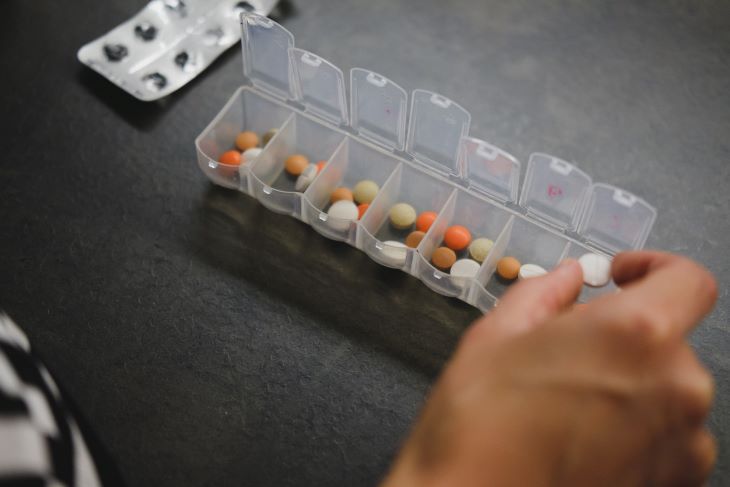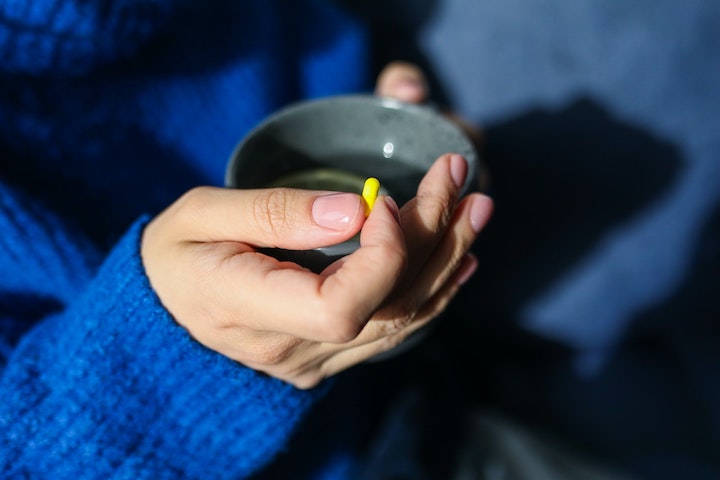Xanax (Niravam) is commonly prescribed on the NHS to treat anxiety and panic disorders. Xanax is the trademark for the drug Alprazolam.
Xanax is classed as a ‘Benzodiazepine’ sedative. Xanax works by causing the brain to release the relaxant hormone ‘GABA’. Xanax is a depressant and tranquilliser.
Users build up a tolerance to Xanax meaning ever greater quantities of the drug are required in order to experience the desired ‘high’. Over time users require Xanax in order to function. A preoccupation with Xanax slowly takes over the addict’s life.

If you’ve already encountered the terminology surrounding drug use, you’ve likely heard these two terms used seemingly to describe the same scenario.
In truth, they refer to very different situations. Identifying the difference between addiction and dependence is a key part of gauging the severity of someone’s drug use, and the type of Xanax detox needed to instil their recovery.
Formerly, someone would be diagnosed as having an addiction if they exhibited an intense physical need to use a substance. Conversely, an individual was described as having a dependence if they experienced a purely mental reliance on drugs or alcohol.
This way of thinking establishes a binary of physical vs psychological that experts have noted is unhelpful when treating addiction. In keeping with the view that someone can experience both physical and psychological symptoms, the term “dependence” has since been updated.
The term now refers to a pattern of substance use that has established a reliance, but not a life-altering hold over someone’s life.
In this way, many Xanax users begin their relationship with the drug. In the majority of cases, it is prescribed as a psychiatric medication for managing mental illnesses such as Generalized Anxiety Disorder.
However, tolerance to Xanax builds quickly, and an individual may need to take more and more: becoming dependent on the drug. While at this point, Xanax use has not completely taken over someone’s life and well-being, it is only a matter of time.
With continued use, the individual may develop an addiction. This condition differs from dependence in that it causes users to make procuring and taking Xanax a priority.
As such, those who are dependent on Xanax but not addicted to the drug may benefit from an outpatient detox: as their symptoms can be easily managed.
In contrast, those with a moderate to severe Xanax use disorder must seek an inpatient Xanax detox immediately where they can withdraw safely from the drug.

Xanax is frequently described as one of the most addictive types of benzodiazepines and is also one of the most prescribed.
Though Xanax can be very effective for treating conditions such as Generalised Anxiety Disorder (GAD) and depression, its highly addictive nature puts those taking the drug beyond 6 weeks at risk of developing Xanax use disorder.
Xanax use disorder is associated with pleasurable effects or a sense of feeling “high” when the drug is consumed at a high dose. Oftentimes, addiction develops both due to this high, and the self-medication that it provides for anxiety disorders.
The condition is then complicated by efforts to avoid withdrawal symptoms. These are particularly severe in the context of Xanax use because, even at low doses, the drug has a short half-life of just 11 hours.
This means that the pleasurable effects of Xanax quickly dissipate: causing people to develop tolerance to the drug. Over time, the duration of its therapeutic effects becomes shorter, while the feeling of “comedown” and associated withdrawal symptoms comes quicker.
This is particularly dangerous if an individual attempts to quit Xanax unaided: a process that leads to such severe withdrawal that the negatives of quitting quickly outweigh the positives.
However, not everyone who is medically prescribed Xanax will develop an addiction. Such a condition develops due to a variety of cognitive, behavioural, and physiological symptoms leading to an individual continuing to use Xanax despite adverse health or emotional effects.

Often the first step in someone’s recovery journey, Xanax detox is the process that helps individuals safely stop taking the drug.
This is usually achieved via a process of gradual discontinuation: also known as tapering, wherein someone takes less and less Xanax until all traces are removed from the system.
Due to long-lasting memory and the risk of developing a range of serious health conditions, it’s crucial for those struggling with addiction to get help with the Xanax detox process.
The abrupt discontinuation of Xanax use can lead to complications such as panic attacks, insomnia, psychosis, and even seizures.
Therefore, undertaking detox with medical supervision reduces the risk of these complications and helps individuals experience a comfortable, safe start to their recovery.
During Xanax detox, patients work through a personalised detoxification plan that has been created by their doctor.
A major part of each Xanax detox strategy is implementing a unique tapering schedule: where the clinician reduces someone’s benzodiazepine dose gradually over time until they are no longer dependent on the substance. This helps to relieve the majority of severe withdrawal symptoms and prevent dangerous seizures.
Bespoke Xanax detox strategies are influenced by a variety of factors unique to each patient: such as pre-existing health issues, co-occurring disorders, addiction severity, and treatment preferences.
These details will shape the basic structure for Xanax detoxification, which is as follows:

Depending on the individual’s dosage and the length of time they’ve used the drug, the Xanax withdrawal timeline can start a few hours after the last dose and can last several weeks or longer.
Harrowingly, the use of Xanax, even as directed for as little as 3 weeks can result in dependence and withdrawal upon abstinence.
The average withdrawal symptom duration depends on an individual’s severity and pattern of Xanax use, alongside their overall health. While some people experience symptoms for around two months, others will stabilise and feel completely better in a matter of weeks.
In general, the longer the time and the higher the doses are taken, the more dangerous and agonizing the symptoms can be. The following is a general idea of the symptoms to expect, and roughly when to expect them in the Xanax withdrawal timeline.

Typically, Xanax withdrawal will begin within 24 hours after someone’s last dose, In this time frame, symptoms can be quite distressing and potentially dangerous.
During the first 1-3 days, symptoms are usually at their worst, and patients are at a higher risk of developing seizures than at any other point in the Xanax detox process.
General withdrawal symptoms that are likely to occur at this time include mood swings, increased heart rate, and insomnia.
Moreover, patients experiencing these general withdrawal symptoms within the first 72 hours are also at risk of developing rebound symptoms. This means that the symptoms Xanax was originally prescribed to alleviate (anxiety, depression, OCD) return with a vengeance.
As such, undergoing Xanax detox under the supervision of a clinician is highly recommended. Receiving round-the-clock medical care means you’ll avoid hazardous complications in this crucial preliminary stage.

While the most severe symptoms of Xanax withdrawal will have passed by the seventh day, many remain and detox is by no means easy.
Many addicted individuals note that in this time, their heart continues to race, they have immense difficulty sleeping, and withdrawal symptoms are making them irritable or easily agitated.
Psychological symptoms may also begin: including intense depression and mood swings. Cravings also present during this time, making it difficult for addicted individuals to think of anything outside of using Xanax.

In the second week of Xanax detox and withdrawal, many of the same emotional symptoms are pervasive.
Specifically, depressive symptoms, agitation, and insomnia are yet to pass. However, by this time, the risk of developing seizures and other acute withdrawal syndromes has passed.

During the second 2 weeks, sleeping problems may become less severe but may continue in a lesser form for some time post-detox. Meanwhile, physical symptoms such as headaches will begin to lessen in severity.
While the above symptoms may fade, the mental and emotional symptoms may still be present. Unfortunately, this includes the original anxiety or depression that Xanax initially helped to alleviate.

After one month has passed, the majority of those in recovery experience a significant reduction in withdrawal symptoms.
Despite this, individuals with chronic Xanax addiction may find that adverse symptoms stay with them for up to one year.
While continuing treatment helps individuals tackle the root cause of their addiction, many people report ongoing cognitive effects such as short-term memory problems, headaches, and loss of coordination.
Other stubborn symptoms include mild levels of paranoia, alongside physical symptoms such as muscle pain and stomach cramps.

Also known as Post-Acute Withdrawal Syndrome (PAWS), Benzodiazepine Protracted Withdrawal Syndrome (PWS) occurs in those who continue experiencing adverse symptoms despite already completing Xanax detox.
The persistence of these symptoms, sometimes for months or years post-cessation, is the main feature of this condition: hence the use of “protracted“.
PWS is a distressing syndrome for both those experiencing it first-hand and their loved ones. Protracted symptoms occur due to major functional changes in the brain’s neuroreceptors and parts of the central nervous system most affected by Xanax.
Oftentimes, the post-detox withdrawal symptoms associated with benzodiazepine-addicted individuals resolve within 6–18 months of their final dose. While some people recover in a shorter amount of time than this, others may take longer than 2.5 years.
Moreover, scientists are now discovering a potential genetic predisposition that occurs during the regular withdrawal process and shifts the experience into a protracted withdrawal syndrome. However, it has also been noted that further studies are needed.
What addiction experts know for sure is that those who have taken benzodiazepines long-term: e.g. over 10 years are prone to having bad experiences during their Xanax detox.

Many addicted individuals are sceptical of entering a rehab clinic for their Xanax detox. This may be due to warranted financial concerns, or simply a fear of the unknown.
However, while it might sound like the easier option, detoxing from benzodiazepines at home is fraught with risk: prompting many people to ask the question “how safe is undergoing Xanax detox at home?”.
As previously mentioned, Xanax withdrawal is an uncomfortable process and can be life-threatening when not managed properly. As such, many benzodiazepine addiction specialists won’t recommend home detox to their patients.
The biggest risk associated with a home Xanax detox is that many individuals lack the appropriate and adequate understanding of benzodiazepine withdrawal symptoms and their management.
This leads many individuals to quit “cold turkey”: the process of abruptly discontinuing Xanax use without a proper tapering schedule.
Trying to detox without a bespoke tapering schedule that considers the length, frequency, and amount of Xanax in your system will lead to complications.
Individuals are at risk of experiencing symptoms such as intense difficulty sleeping, depression, or signs of post-acute withdrawal syndrome (PAWS): a chronic condition lasting for months or years
Unfortunately, the discomfort experienced during Xanax withdrawal can lead one to reuse it: with relapse rates higher in cases of home detox than in any other treatment setting. Reusing Xanax might seem like the only way to access relief when suffering from physical and mental discomfort.
Additionally, undergoing a home Xanax detox puts those with co-occurring disorders at risk of physical and/or psychological harm. Rebound symptoms are common in those who were originally prescribed Xanax treat anxiety or depression.
This means the symptoms of their co-occurring disorder may return tenfold during their detox. As such, individuals are advised to undergo Xanax detox at a certified medical centre under the direct supervision of qualified clinicians and psychiatrists.

With adverse symptoms developing as soon as 6 hours post Xanax use, it’s no wonder that many experts consider home detox a dangerous pursuit.
While not completely off the cards, patients wishing to opt for a home Xanax detox must first consult a clinician to receive clarity about their addiction.
The most obvious group of individuals eligible for detoxing at home are those with mild Xanax dependencies or those who have just started using the drug problematically. Their withdrawal symptoms will likely be minimal, and easy to manage by resting, eating nutritious foods, and staying hydrated.
However, it’s crucial even for those with mild addictions to have a supportive network around them at home.
Family members, friends, or a supportive neighbour should be on hand to support the addicted individual, either by taking them to doctor appointments, ensuring they are eating well, or simply providing emotional assistance.
Furthermore, someone undertaking a home Xanax detox should be high functioning. This means they can maintain regular contact with their doctor or pick up prescribed medications from their local pharmacy.
Even if you resonate with the above situations, the decision to undertake a home Xanax detox should always be made with the help of a medical professional.
Fortunately, a professional opinion can be easily accessed, either through your GP, an NHS addiction specialist or here at Rehab 4 Addiction. Simply call a member of our expert team on 0800 140 4690.

Deciding to undertake a professionally supervised Xanax detox is an important first step toward recovery, and is a show of great courage.
However, before starting your detox, there are two main treatment settings to choose from here in the UK.
They are inpatient detox: a more intensive treatment style, and outpatient detox: a more remote way of receiving professional guidance.

When we first envisage the detox process, we often think of staying overnight at a detox centre: otherwise known as inpatient treatment.
Thanks to its provision of 24-hour supervision, it is often recommended to undertake Xanax detox at one of these approved medical centres.
Upon their admission to an inpatient benzodiazepine addiction clinic, patients are supervised by clinicians day and night. On-site doctors and nurses provide a range of care that is tailored to suit each individual: from prescribing medication, to ensuring patients remain nutritionally stable.
Oftentimes, a vital component of inpatient Xanax detox is Medically Assisted Treatment (MAT). The exact medical strategy prescribed to each patient is decided during their pre-admission health evaluation, and modified throughout the detox to suit their emerging needs.
Alongside MAT, each patient has a personalised tapering schedule: the process by which Xanax levels in the body are lowered.
For example: after the initial reduction by around 30% on day 2 or 3, the dose is reduced by approximately 10-25% at a time. For those who experience difficulty with this rate, dose reduction is carried out at a slower rate of 5-10%.
Although MAT and on-site tapering are an important part of inpatient detox, further rehabilitation is often needed to address the co-occurring disorders that often underlie benzodiazepine addictions.
A patient’s case worker at an inpatient rehab clinic will design a series of behavioural therapies and counselling sessions.

For many people, their Xanax detox takes place via an outpatient programme.
Often facilitated by the NHS, this strategy is popular among those who are functioning well and are keen to continue living their lives uninterrupted. They’ll continue to live at home with their families: attending medical appointments in a pre-arranged time slot.
While patients do not stay at a rehab clinic overnight, this doesn’t mean they have no contact with medical professionals. Before starting their detox, they must undertake a health evaluation and consultation in which their tapering strategy is decided alongside doctor visitations.
As with every other aspect of addiction treatment, the regularity of doctor’s appointments depends entirely on the individual.
Some people, particularly those with severe benzodiazepine addictions, will see their doctor every day or every other day. However, those with mild dependencies might only need to see a professional once per week.

Fortunately, there are various medications available to treat the symptoms of acute withdrawal that occur during Xanax detox.
In the majority of cases, addicted individuals receive a combination of tapering treatment, and either anti-depressants or over-the-counter medication to manage their unique symptoms.
Before your medically supervised Xanax detox, a clinician will evaluate your withdrawal potential, while considering other aspects of health and personality to curate a personalised medical strategy.
Withdrawal symptoms are also managed as they arise, thanks to the 24-hour supervision available in residential detoxes.
Many Xanax detox strategies also involve administering alternative benzodiazepines in gradually reducing amounts. In many cases of severe Xanax addiction, doctors will prescribe switching to a longer-acting drug from the same family, such as clonazepam or diazepam.
This temporary process aims to stabilize the patient during their detox before gradually reducing the dose. This also decreases the severity of withdrawal symptoms: allowing patients to maintain a higher quality of life during this time.
While medication has its place, it is not the be-all and end-all of addiction treatment, and rarely ensures abstinence longevity.
After completing their Xanax detox, patients begin non-pharmacological treatment approaches in the form of cognitive restructuring and cognitive-behavioural strategies. In this day and age, there is a range of therapies offered to both inpatients and outpatients.

While medication has its place and helps patients maintain comfort during their Xanax detox, it is a short-term solution.
Following their stabilisation, patients can only achieve long-term sobriety by undertaking comprehensive rehabilitation in which they’ll encounter a range of therapies.

Of the therapeutic tools for achieving and maintaining successful recovery post-Xanax detox, group therapy is an important method. Group Support Therapy is an umbrella term for any type of therapy aimed at implementing recovery and symptom management in two or more individuals.
This style of psychological therapy allows people with the same issue (in this case, Xanax addiction) to come together, support one another, and ultimately work through their addiction issues as a team.
Group support therapy sessions are structured according to the treatment modality (inpatient vs outpatient) or preference of the facilitator. This will often be a mental health professional, such as a therapist, psychiatrist, or social worker.
Discussions involve listening to the experiences of others, sharing the coping skills that patients have learnt during individual therapy, and working through CBT techniques.
Session topics include discussing gratitude, how Xanax use impacts daily life and discussing relapse trigger management.
Depending on the requirements of their treatment programme, individuals will often partake in group therapy over several weeks or more. For inpatients, group sessions may take place on a more regular basis as part of their residential treatment plan.

Family-centric therapies are an indispensable resource for those undergoing addiction treatment. Rather than simply targeting one symptom of their Xanax addiction, FBT helps patients resolve issues within their family unit that their Xanax use disorder may have caused.
Those participating in FBT will have two aims: to reduce the harm of addiction on both the substance abuser and his or her family and to rebuild lost closeness in these relationships.
It’s also possible for additional issues to be addressed in FBT sessions, including problematic parenting skills, mental illness, abuse, and general conflict within the family.
Therapeutic methods that utilize a patient’s support network are the best way to improve the chances of lifelong sobriety. With the expert presence of a therapist, FBT sessions take place at a treatment centre that is convenient for participants to attend.
This might consist of appointments or multiple weekends falling on a pre-discussed date.
During these workshops, discussions and activities include education, communication enhancement, conflict resolution, behavioural change, and active engagement.
For example, family members and addicted individuals must be given the information and resources they need to understand the Xanax addiction recovery process.

Since CBT was invented in the late 20th century, its methods have been utilised in treatment programmes across the world.
During sessions in rehab for Xanax, a CBT therapist’s role is to help patients develop an awareness of the negative thoughts that lead to a poor self-image.
These are known as cognitive distortions and often appear in form of negative self-talk such as “I can’t do anything right”.
Over time, this leads to self-destructive behaviours such as substance misuse: fuelled by untrue beliefs that the individual has formed about themselves, their emotions, and the world around them.
Restructuring and uncovering the negative core beliefs that have become a part of someone’s subconscious are the core principles of Cognitive Behavioural Therapy.
Specifically, in cases of Xanax use disorder, CBT sessions may explore the implications of further use, learning to recognise cravings, and developing strategies to control them.

As another form of behavioural intervention, Dialectical Behavioural Therapy has been a staple of addiction treatment since its ability to treat more than depressive symptoms was realised.
Its methodology is considered highly effective in those with co-occurring mental health problems or a history of trauma.
The DBT approach stems from the idea that some people react to negative emotions or stress more intensely than others. To manage this, DBT implements its leading principle: one that is inherent in the name “dialectical” therapy.
The term dialectic describes two very different ideas working in unison; in this case, accepting the way that we feel while finding new ways to change how we deal with such emotions.
With this in mind, DBT sessions teach patients ways to emotionally regulate, mindfulness skills, distress management, and how these skills trans; ate into relapse prevention.

Tied to a system of rewards, Contingency Management (CM) is a type of behavioural conditioning that seeks to teach patients that by changing their actions, a better life is possible.
In the realm of Xanax addiction treatment, this type of operant conditioning rewards participants only when they visibly meet the requirements of their inpatient or outpatient recovery programme.
For instance, if a patient tests negative for Xanax in their system, the CM programme could provide them with a reward, which could be a voucher for a service or even a cash prize of varying value.
The programme might also implement a bonus scheme wherein the more negative drug tests a person provides, the higher their rewards will be in value.

Holistic Therapy (also Alternative Therapy) is a broad term used to describe a group of healthy, positive activities that are proven to aid addiction recovery.
Once met with much criticism among clinicians, it is now applauded for its ability to help patients look after their physical, mental, and emotional well-being.
It achieves this by taking an individual as a whole into account, instead of tackling a specific symptom or issue using medications. HT programmes implemented in Xanax addiction treatment allow subjects to choose a variety of healthy, creative hobbies.
Some HT classes allow patients to express their thoughts and behaviours through imaginative and creative tasks: such as art or music therapy. Others focus on mindfulness techniques and breathwork: achieved through yoga and meditation practices.

If you find yourself in a situation wherein a loved one has been offered treatment and refused it, this is an unfortunately common scenario among addicted individuals.
While the benefits of Xanax detox and rehabilitation are clear to their families, many SUD victims struggle to come to terms with their addiction: an internal struggle that often manifests as denial.
Fortunately, this isn’t an impossible situation to be in, and help is available in the form of professional intervention. Here at Rehab 4 Addiction, our team are trained in intervention facilitation and can help point you in the right direction.
Many people know the intervention process by how it is presented in the media: a false representation that depicts confrontation.
In reality, an intervention is a sympathetically delivered psychiatric technique. Meetings involve loved ones coming together to share their emotions, thoughts, and perspectives with the individual refusing treatment.
Furthermore, interventions are rarely completed throughout one, explosive meeting. Interventions are normally carried out over several meetings to keep emotions regulated and discussions focused.
Loved ones may decide to read out impact statements in the hope that their loved one will accept treatment. This treatment has often been pre-planned to ensure a smooth transition into Xanax detox.
With so much to coordinate, an intervention should never be planned alone. As such, many family units seek out an interventionist in their area. They are addiction specialists with experience in guiding interventions in their entirety.
Interventionists follow a highly structured guideline when helping families reach an addicted loved one through the haze of denial. Such criteria are always clinically approved, and are carried out in the following manner:

At Rehab 4 Addiction we believe the simplest and most effective way of treating Xanax addiction is by undergoing a programme of residential rehabilitation.
Xanax causes a range of physical and psychological withdrawal symptoms and so a medically assisted detox is always advisable. Since Xanax interferes with the brain’s GABA hormones when the drug is abruptly withdrawn the brain goes into a state of hyperactivity.
This hyperactivity is capable of causing cardiac arrest and/or life-threatening seizures. In fact, the United Kingdom sees around 100 Xanax-related deaths each year (source: Office of National Statistics).
Residential rehabilitation means patients are under the watchful eye of our medical team. Trained doctors and nurses monitor patients during the acute detox period.
The risk of seizures is all but reduced through the use of a tapered detox regime coupled with the use of non-addictive anti-anxiety medications.
Given the level of discomfort patients experience during the acute withdrawal period, we recommend patients attend a four-week rehabilitation programme.
This allows patients enough to spend time to complete their detox but also enough time remains to treat underlying emotional triggers during therapy and counselling sessions.

Common withdrawal symptoms experienced during a non-medically supervised detox include:
Before patients are admitted into our centre a full medical assessment takes place. The majority of Xanax addicts experience a co-dependency with other drugs.
This is typically alcohol, heroin or crack cocaine. A personalised rehabilitation plan is put in place ensuring all co-dependencies are identified from the outset and treated accordingly.

Once patients are discharged from our rehabilitation centre a number of safeguards are put in place to reduce the risk of relapse.
Twelve months of aftercare is provided free of charge following the successful completion of rehabilitation. Aftercare sessions take place at the rehabilitation centre where patients attended.

If you would like to learn more about our Xanax rehabilitation programme please call our admissions team today on 0800 140 4690.
Alternatively, complete the enquiry form and a member of our team will reply to your message shortly. If a loved one is suffering from Xanax addiction why not consider our intervention service.
[1] Novel benzodiazepines: prevalence and harms in the UK Novel benzodiazepines: prevalence and harms in the UK – GOV.UK (www.gov.uk)
[2] Addiction to benzodiazepines and codeine Addiction to benzodiazepines and codeine – GOV.UK (www.gov.uk)
[3] Alprazolam (Xanax): What are the facts? Alprazolam (Xanax): What are the facts? – UK Health Security Agency (blog.gov.uk)
[4] Drug Misuse in England and Wales: Year Ending March 2020 https://www.ons.gov.uk/peoplepopulationandcommunity/crimeandjustice/articles/drugmisuseinenglandandwales/yearendingmarch2020
[5] Adult Substance Misuse Treatment Statistics 2020 to 2021: Report https://www.gov.uk/government/statistics/substance-misuse-treatment-for-adults-statistics-2020-to-2021/adult-substance-misuse-treatment-statistics-2020-to-2021-report
[6] Deaths Related to Drug Poisoning by Local Authority https://www.ons.gov.uk/peoplepopulationandcommunity/birthsdeathsandmarriages/deaths/datasets/drugmisusedeathsbylocalauthority
[7] Beyond Benzos: Benzo Addiction, Benzo Withdrawal, and Long-term Recovery from Benzodiazepines Beyond Benzos – Google Books
[8] The Dialectical Behavior Therapy Skills Workbook: Practical DBT Exercises for Learning Mindfulness, Interpersonal Effectiveness, Emotion Regulation, and Distress Tolerance The Dialectical Behavior Therapy Skills Workbook – Google Books
[9] Cognitive, Clinical, and Neural Aspects of Drug Addiction Cognitive, Clinical, and Neural Aspects of Drug Addiction – Google Books
[10] Overcoming Prescription Drug Addiction: A Guide to Coping and Understanding Overcoming Prescription Drug Addiction: A Guide to Coping and Understanding – Rod Colvin – Google Books
[11] Frontiers – Resocialising the Vulnerable Brain: Building an Ethically Sustainable Brain Disease Model of Addiction https://www.frontiersin.org/articles/10.3389/fsoc.2018.00039/full#:~:text=The%20brain%20disea
[12] Alprazolam Addiction (Xanax), How I Won The Battle: A Detailed Account of Exactly how I Ended My Dependancy on Xanax Alprazolam Addiction (Xanax) How I Won The Battle – Google Books
[13] Motivational Interviewing https://www.racgp.org.au/afp/2012/september/motivational-interviewing-techniques
[14] Cognitive Behavioural & Relapse Prevention Strategies Cognitive Behavioural & Relapse Prevention Strategies (unodc.org)
[15] Calming the Brain: Benzodiazepines and Related Drugs from Laboratory to Clinic Calming the Brain – Google Books
[16] The Benzodiazepines Crisis The Benzodiazepines Crisis – Google Books
[17] Young People’s Substance Misuse Treatment Statistics 2020 to 2020: Report Young people’s substance misuse treatment statistics 2020 to 2021: report – GOV.UK (www.gov.uk)
[18] Smoking, Drinking, and Drug Use among Young People in England 2018 [NS] Smoking, Drinking and Drug Use among Young People in England 2018 [NS] – NHS Digital